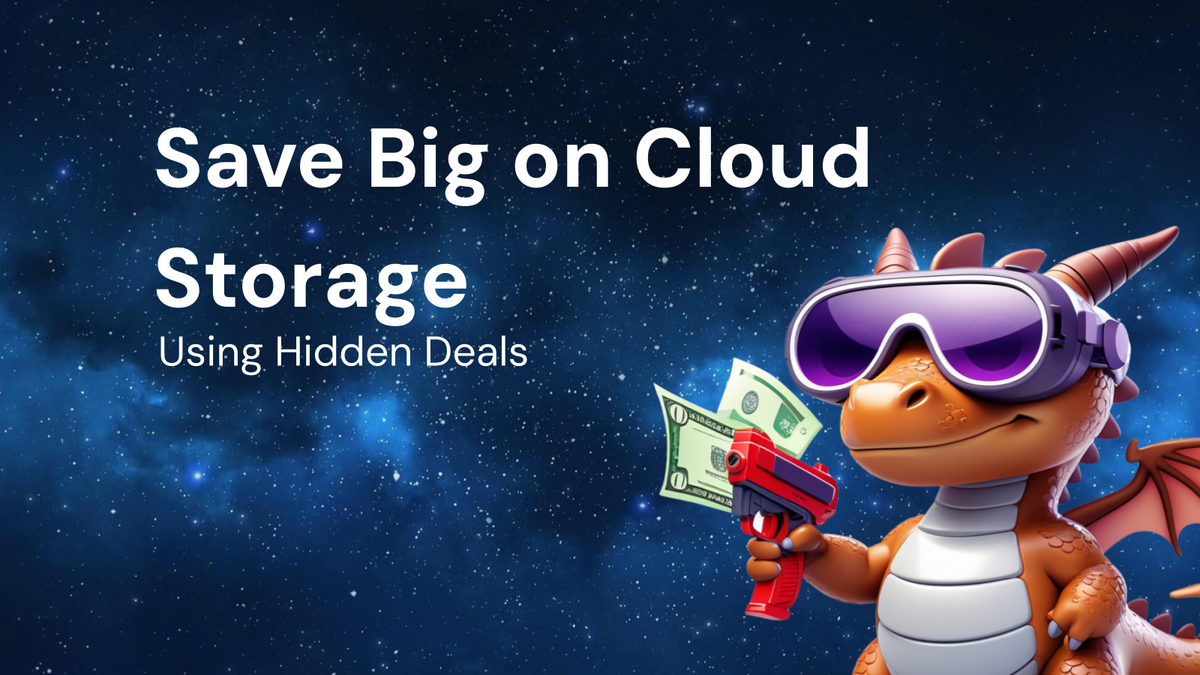Pricing Breakdown: Save Big on cloud storage Using hidden deals

Pricing Breakdown: Save Big on Cloud Storage Using Hidden Deals
In today's digital landscape, cloud storage has become an indispensable tool for individuals and businesses alike. From safeguarding precious memories to facilitating seamless collaboration, the cloud offers a plethora of benefits. However, navigating the complex world of cloud storage pricing can be daunting. Providers often bombard consumers with tiered plans, hidden fees, and promotional offers that can leave you feeling more confused than informed.
This article aims to demystify the world of cloud storage pricing, revealing strategies and "hidden deals" that can help you save big without compromising on your storage needs. We're not here to sell you a specific service or push a particular provider; instead, we're here to empower you with the knowledge to make informed decisions and find the best cloud storage solution at the most competitive price.
Understanding the Basics of Cloud Storage Pricing
Before diving into the hidden deals and cost-saving strategies, let's establish a foundational understanding of how cloud storage providers typically structure their pricing. Several factors influence the cost, including:
- Storage Capacity: This is the most straightforward factor. Providers charge based on the amount of storage space you require, usually measured in gigabytes (GB) or terabytes (TB). Larger storage capacities naturally come with higher price tags.
- Bandwidth: Bandwidth refers to the amount of data transferred to and from the cloud within a specific period (typically a month). Some providers impose bandwidth limits and charge extra fees if you exceed them, especially if you are frequently uploading or downloading large files.
- Features and Functionality: The features included in a plan can significantly impact the price. Basic plans usually offer core storage and sharing capabilities, while premium plans might include advanced features like version history, collaboration tools, enhanced security, and priority support.
- Number of Users: For business-oriented cloud storage solutions, the pricing often depends on the number of users who will be accessing the storage. Each user typically requires a separate license or account.
- Data Redundancy and Availability: Providers invest in infrastructure to ensure your data is safe and accessible. Higher levels of redundancy (multiple copies of your data stored in different locations) and guarantees of uptime (the percentage of time the service is operational) often translate to higher prices.
- Subscription Model: Cloud storage is typically offered on a subscription basis, with recurring monthly or annual fees. Longer subscription periods sometimes come with discounts.
Decoding the Fine Print: Identifying Hidden Fees
Many cloud storage providers advertise seemingly attractive prices, but it's crucial to scrutinize the fine print to uncover any hidden fees that could significantly inflate your costs. Here are some common hidden fees to watch out for:
- Overage Fees: Exceeding your storage or bandwidth limits can trigger hefty overage fees. Always carefully estimate your storage and bandwidth requirements to avoid unexpected charges.
- Download Fees: Some providers, especially those catering to businesses with large data archives, charge fees for downloading your data. These fees can be substantial if you need to retrieve large files frequently.
- Early Termination Fees: If you decide to cancel your subscription before the end of the contract period, you might be subject to early termination fees.
- API Usage Fees: For developers and businesses integrating cloud storage into their applications, providers may charge fees for using their application programming interface (API).
- Data Migration Fees: Moving your existing data to a new cloud storage provider can sometimes incur migration fees, especially if you require assistance from the provider.
- Support Fees: While basic support is often included in the subscription price, premium support options like priority access or dedicated account managers can come with additional fees.
Unveiling Hidden Deals and Cost-Saving Strategies
Now that you have a better understanding of cloud storage pricing and potential hidden fees, let's explore some strategies and "hidden deals" that can help you save money:
1. Leverage Free Tiers and Trials:
Many cloud storage providers offer free tiers with limited storage capacity (e.g., 5GB, 15GB) or free trials of their paid plans. This is an excellent way to test out different services, assess their features, and determine if they meet your needs before committing to a paid subscription. Don't underestimate the value of these free options, especially if your storage requirements are modest. You might find that a combination of free tiers from different providers suits you perfectly.
- Search Term: "Free cloud storage" or "[Provider Name] free trial"
2. Hunt for Introductory Offers and Promotional Discounts:
Cloud storage providers frequently run promotional campaigns and offer introductory discounts to attract new customers. These offers can include reduced monthly rates, increased storage capacity, or free add-on features. Keep an eye out for these deals, especially during holidays or special events like Black Friday or Cyber Monday. Sign up for email newsletters from various providers to stay informed about their latest promotions.
- Search Term: "[Provider Name] promo code" or "Cloud storage deals"
3. Consider Annual Subscriptions:
Opting for an annual subscription instead of a monthly plan often results in significant savings. Providers typically offer a discounted rate for annual commitments, as it provides them with predictable revenue. Compare the monthly cost of a plan with the annual cost to see how much you can save.
- Comparison Tip: Calculate the monthly equivalent cost of the annual subscription to make an accurate comparison.
4. Explore Bundled Services and Partner Programs:
Some cloud storage providers partner with other companies to offer bundled services. For example, you might find deals that combine cloud storage with productivity suites, security software, or domain registration. These bundles can be a cost-effective way to acquire multiple services at a discounted price. Also, investigate partner programs that may offer discounts or commissions for referring new customers.
- Search Term: "Cloud storage bundle" or "[Provider Name] partner program"
5. Optimize Your Storage Usage:
Efficiently managing your storage space can help you avoid upgrading to a more expensive plan. Here are some tips for optimizing your storage usage:
- Compress Large Files: Use compression tools like ZIP or 7-Zip to reduce the size of large files before uploading them to the cloud.
- Delete Unnecessary Files: Regularly review your cloud storage and delete any files that you no longer need.
- Archive Infrequently Accessed Data: Move older, infrequently accessed files to a less expensive archive storage option if your provider offers one.
- Avoid Duplicates: Be mindful of creating duplicate files. Use file management tools to identify and remove any redundant copies.
- Convert to Cloud-Friendly Formats: Convert large media files (e.g., videos, images) to cloud-friendly formats with smaller file sizes without significant loss of quality.
6. Compare Pricing Across Different Providers:
Don't settle for the first cloud storage provider you encounter. Take the time to research and compare pricing across different providers. Use comparison websites and online reviews to get a comprehensive overview of the available options. Pay close attention to the features included in each plan and any potential hidden fees.
- Comparison Websites: Search for "cloud storage comparison" on Google or other search engines.
7. Evaluate Alternative Storage Solutions:
Cloud storage isn't the only option for storing your data. Depending on your needs, you might consider alternative solutions like:
- Network-Attached Storage (NAS): A NAS device is a dedicated storage server that you can connect to your home or office network. It provides local storage that you can access from multiple devices. While NAS requires an upfront investment, it can be more cost-effective in the long run, especially for large storage needs.
- External Hard Drives: External hard drives are a simple and affordable way to store large amounts of data. However, they are less convenient than cloud storage or NAS, as they need to be physically connected to your devices.
- Hybrid Approach: Combining cloud storage with local storage (e.g., NAS or external hard drives) can provide a balance of convenience, security, and cost-effectiveness.
8. Take Advantage of Educational or Non-Profit Discounts:
Many cloud storage providers offer discounted rates to students, educators, and non-profit organizations. If you qualify for one of these discounts, be sure to take advantage of it. You might need to provide proof of eligibility, such as a student ID or a letter of exemption.
- Search Term: "[Provider Name] student discount" or "[Provider Name] non-profit discount"
9. Negotiate Enterprise Pricing:
If you're a business with significant storage needs, don't hesitate to negotiate enterprise pricing with cloud storage providers. You might be able to secure a better deal by committing to a larger storage capacity or a longer contract period. Be prepared to provide detailed information about your storage requirements and usage patterns.
- Contacting Sales: Most providers have dedicated sales teams for enterprise clients. Reach out to them directly to discuss your needs and explore pricing options.
10. Pay Attention to Data Residency and Compliance:
For businesses handling sensitive data, data residency and compliance requirements are crucial considerations. Data residency refers to the physical location where your data is stored. Some regulations require data to be stored within a specific country or region. Make sure the cloud storage provider you choose complies with all applicable regulations and offers data residency options that meet your needs. Non-compliance can result in hefty fines. This might indirectly influence your pricing, as compliant services might charge a premium.
- Search Term: "[Provider Name] data residency" or "Cloud storage compliance [Your Industry]"
11. Consider Cloud Storage Gateways
Cloud Storage Gateways act as a bridge between your on-premises infrastructure and the cloud. They cache frequently accessed data locally, reducing latency and bandwidth consumption. This can lead to significant cost savings, especially for organizations with high data access needs. These gateways allow for hybrid cloud environments, where some data remains on-site for compliance or performance reasons, while other data resides in the cloud.
- Search Term: "Cloud Storage Gateway Solutions"
12. Monitor Your Usage and Adjust Accordingly
Your storage needs can change over time. Regularly monitor your cloud storage usage to identify areas where you can optimize your storage or adjust your plan. If you consistently use less storage than you're paying for, consider downgrading to a smaller plan. Conversely, if you're constantly exceeding your storage limits, it might be time to upgrade. This proactive approach to monitoring usage is one of the easiest ways to control costs.
- Utilize Provider Dashboards: Most providers offer dashboards that track storage usage, bandwidth consumption, and other relevant metrics.
13. Automate Data Tiering
Many cloud providers offer automated data tiering options. This involves automatically moving data between different storage tiers based on frequency of access. For instance, data that's frequently accessed might be stored on a faster, more expensive tier (like SSD-based storage), while data that's rarely accessed is moved to a cheaper, archive-focused tier (like HDD-based storage or cold storage). Automating this process ensures you’re always paying the lowest possible price for the type of storage you need.
- Search Term: "[Provider Name] data tiering"
Conclusion: Mastering the Art of Cloud Storage Savings
Finding the best cloud storage solution at the most competitive price requires a proactive and informed approach. By understanding the basics of cloud storage pricing, identifying hidden fees, and leveraging the strategies outlined in this article, you can unlock "hidden deals" and save big without compromising on your storage needs. Remember to regularly monitor your usage, compare pricing across different providers, and explore alternative storage solutions to ensure you're always getting the best value for your money. Don't be afraid to negotiate, leverage free trials, and hunt for promotional discounts. With a little effort and research, you can master the art of cloud storage savings and enjoy the benefits of the cloud without breaking the bank.




